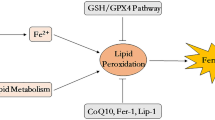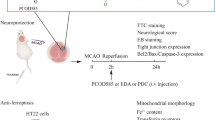Abstract
Homocysteine (Hcy) induced vascular endothelial injury leads to the progression of endothelial dysfunction in atherosclerosis. Epigallocatechin gallate (EGCG), a natural dietary antioxidant, has been applied to protect against atherosclerosis. However, the underlying protective mechanism of EGCG has not been clarified. The present study investigated the mechanism of EGCG protected against Hcy-induced human umbilical vein endothelial cells (HUVECs) apoptosis. Methyl thiazolyl tetrazolium assay (MTT), transmission electron microscope, fluorescent staining, flow cytometry, western blot were used in this study. The study has demonstrated that EGCG suppressed Hcy-induced endothelial cell morphological changes and reactive oxygen species (ROS) generation. Moreover, EGCG dose-dependently prevented Hcy-induced HUVECs cytotoxicity and apoptotic biochemical changes such as reducing mitochondrial membrane potential (MMP), decreasing Bcl-2/Bax protein ratio and activating caspase-9 and 3. In addition, EGCG enhanced the protein ratio of p-Akt/Akt, endothelial nitric oxide synthase (eNOS) activation and nitric oxide (NO) formation in injured cells. In conclusion, the present study shows that EGCG prevents Hcy-induced HUVECs apoptosis via modulating mitochondrial apoptotic and PI3K/Akt/eNOS signaling pathways. Furthermore, the results indicate that EGCG is likely to represent a potential therapeutic strategy for atherosclerosis associated with Hyperhomocysteinemia (HHcy).







Similar content being viewed by others
Abbreviations
- Hcy:
-
Homocysteine
- EGCG:
-
Epigallocatechin gallate
- HHcy:
-
Hyperhomocysteinemia
- HUVEC:
-
Human umbilical vein endothelial cell
- LDH:
-
Lactate dehydrogenase
- MDA:
-
Malondialdehyde
- SOD:
-
Superoxide dismutase
- ROS:
-
Reactive oxygen species
- MMP:
-
Mitochondrial membrane potential
- Akt:
-
Protein kinase B
- p-Akt:
-
Phosphorylated protein kinase B
- eNOS:
-
Endothelial nitric oxide synthase
- NO:
-
Nitric oxide
References
Bautista LE, Arenas IA, Penuela A, Martinez LX (2002) Total plasma homocysteine level and risk of cardiovascular disease: a meta-analysis of prospective cohort studies. J Clin Epidemiol 55:882–887
Refsum H, Ueland PM, Nygard O, Vollset SE (1998) Homocysteine and cardiovascular disease. Annu Rev Med 49:31–62
Clarke R, Daly L, Robinson K et al (1991) Hyperhomocysteinemia: an independent risk factor for vascular disease. N Engl J Med 324:1149–1155
Dong F, Zhang X, Li SY et al (2005) Possible involvement of NADPH oxidase and JNK in homocysteine-induced oxidative stress and apoptosis in human umbilical vein endothelial cells. Cardiovasc Toxicol 5:9–20
Moselhy SS, Demerdash SH (2003) Plasma homocysteine and oxidative stress in cardiovascular disease. Dis Markers 19:27–31
Postea O, Krotz F, Henger A, Keller C, Weiss N (2006) Stereospecific and redox-sensitive increase in monocyte adhesion to endothelial cells by homocysteine. Arterioscler Thromb Vasc Biol 26:508–513
Upchurch GR Jr, Welch GN, Fabian AJ et al (1997) Homocyst(e)ine decreases bioavailable nitric oxide by a mechanism involving glutathione peroxidase. J Biol Chem 272:17012–17017
Lonn E, Yusuf S, Arnold MJ et al (2006) Homocysteine lowering with folic acid and B vitamins in vascular disease. N Engl J Med 354:1567–1577
Toole JF, Malinow MR, Chambless LE et al (2004) Lowering homocysteine in patients with ischemic stroke to prevent recurrent stroke, myocardial infarction, and death: the Vitamin Intervention for Stroke Prevention (VISP) randomized controlled trial. Jama 291:565–575
Woodman RJ, Celermajer DE, Thompson PL, Hung J. (2004) Folic acid does not improve endothelial function in healthy hyperhomocysteinaemic subjects. Clin Sci 106:353–358
Choi YJ, Jeong YJ, Lee YJ, Kwon HM, Kang YH (2005) (-)Epigallocatechin gallate and quercetin enhance survival signaling in response to oxidant-induced human endothelial apoptosis. J Nutr 135:707–713
Guo Q, Zhao B, Li M, Shen S, Xin W (1996) Studies on protective mechanisms of four components of green tea polyphenols against lipid peroxidation in synaptosomes. Biochim Biophys Acta 1304:210–222
Guo Q, Zhao B, Shen S, Hou J, Hu J, Xin W (1999) ESR study on the structure-antioxidant activity relationship of tea catechins and their epimers. Biochim Biophys Acta 1427:13–23
Ou HC, Song TY, Yeh YC, et al. (2010) EGCG protects against oxidized LDL-induced endothelial dysfunction by inhibiting LOX-1-mediated signaling. J Appl Physiol 108:1745–1756
Riemersma RA, Rice-Evans CA, Tyrrell RM, Clifford MN, Lean ME (2001) Tea flavonoids and cardiovascular health. Mon J Assoc Phys 94:277–282
Ludwig A, Lorenz M, Grimbo N et al (2004) The tea flavonoid epigallocatechin-3-gallate reduces cytokine-induced VCAM-1 expression and monocyte adhesion to endothelial cells. Biochem Biophys Res Commun 316:659–665
Tedeschi E, Suzuki H, Menegazzi M (2002) Antiinflammatory action of EGCG, the main component of green tea, through STAT-1 inhibition. Ann N Y Acad Sci 973:435–437
Xu H, Lui WT, Chu CY, Ng PS, Wang CC, Rogers MS (2009) Anti-angiogenic effects of green tea catechin on an experimental endometriosis mouse model. Human Reprod 24:608–618
Wen YD, Wang H, Kho SH et al (2013) Hydrogen sulfide protects HUVECs against hydrogen peroxide induced mitochondrial dysfunction and oxidative stress. PloS One 8:e53147
Brunelle JK, Letai A (2009) Control of mitochondrial apoptosis by the Bcl-2 family. J Cell Sci 122:437–441
Ho FM, Lin WW, Chen BC et al (2006) High glucose-induced apoptosis in human vascular endothelial cells is mediated through NF-kappaB and c-Jun NH2-terminal kinase pathway and prevented by PI3K/Akt/eNOS pathway. Cell Signal 18:391–399
Choy JC, Granville DJ, Hunt DW, McManus BM (2001) Endothelial cell apoptosis: biochemical characteristics and potential implications for atherosclerosis. J Mol Cell Cardiol 33:1673–1690
Mujumdar VS, Aru GM, Tyagi SC (2001) Induction of oxidative stress by homocyst(e)ine impairs endothelial function. J Cell Biochem 82:491–500
Lin R, Liu J, Gan W, Ding C (2007) Protective effect of quercetin on the homocysteine-injured human umbilical vein vascular endothelial cell line (ECV304). Basic Clin Pharmacol Toxicol 101:197–202
Ishikawa K, Takenaga K, Akimoto M et al (2008) ROS-generating mitochondrial DNA mutations can regulate tumor cell metastasis. Science 320:661–664
Ly JD, Grubb DR, Lawen A. (2003) The mitochondrial membrane potential (deltapsi(m)) in apoptosis; an update. Apoptosis 8:115–128
Petit PX, Susin SA, Zamzami N, Mignotte B, Kroemer G. (1996) Mitochondria and programmed cell death: back to the future. FEBS Lett 396:7–13
Sipkens JA, Hahn N, van den Brand CS et al (2013) Homocysteine-induced apoptosis in endothelial cells coincides with nuclear NOX2 and peri-nuclear NOX4 activity. Cell Biochem Biophys 67:341–352
Tyagi N, Ovechkin AV, Lominadze D, Moshal KS, Tyagi SC (2006) Mitochondrial mechanism of microvascular endothelial cells apoptosis in hyperhomocysteinemia. J Cell Biochem 98:1150–1162
Vanhaesebroeck B, Leevers SJ, Panayotou G, Waterfield MD (1997) Phosphoinositide 3-kinases: a conserved family of signal transducers. Trends Biochem Sci 22:267–272
Dimmeler S, Zeiher AM (1999) Nitric oxide–an endothelial cell survival factor. Cell Death Differ 6:964–968
Weiss N (2005) Mechanisms of increased vascular oxidant stress in hyperhomocys-teinemia and its impact on endothelial function. Curr Drug Metab 6:27–36
Acknowledgements
This study was financially supported by the Natural Science Foundation of China (No. 30772601) and the University Innovation Team Project Foundation of Education Department of Liaoning Province (No. LT2013019).
Author information
Authors and Affiliations
Corresponding author
Additional information
Shumin Liu, Zhengwu Sun and Peng Chu equally contributed to the work.
Rights and permissions
About this article
Cite this article
Liu, S., Sun, Z., Chu, P. et al. EGCG protects against homocysteine-induced human umbilical vein endothelial cells apoptosis by modulating mitochondrial-dependent apoptotic signaling and PI3K/Akt/eNOS signaling pathways. Apoptosis 22, 672–680 (2017). https://doi.org/10.1007/s10495-017-1360-8
Published:
Issue Date:
DOI: https://doi.org/10.1007/s10495-017-1360-8




